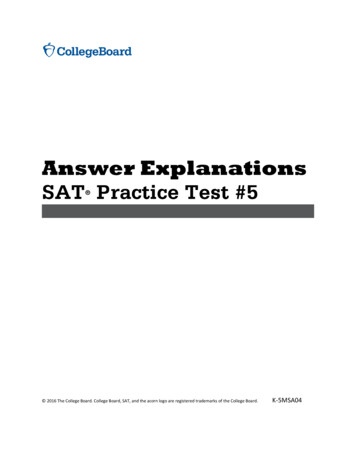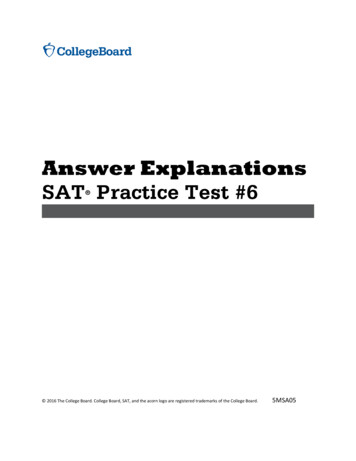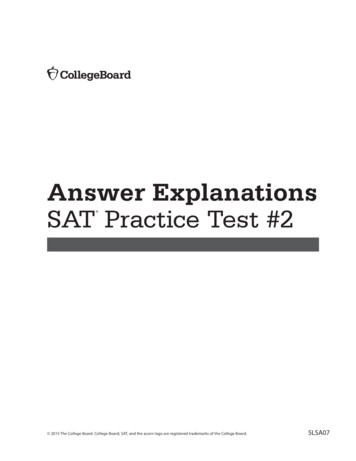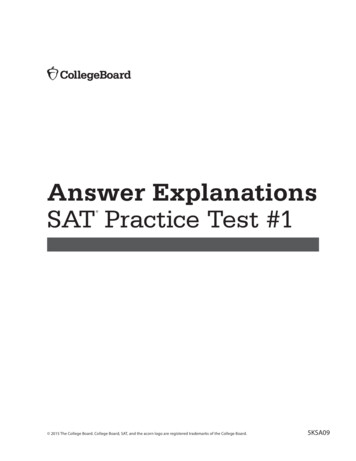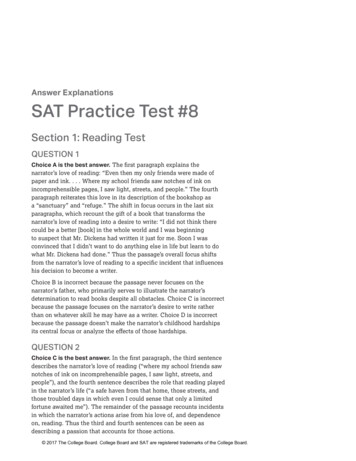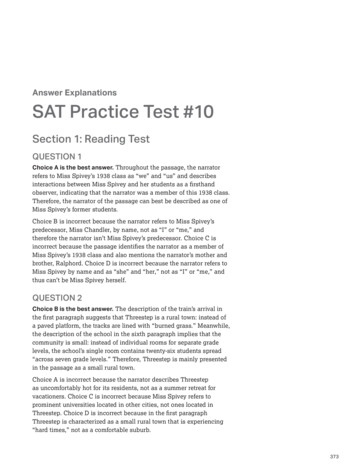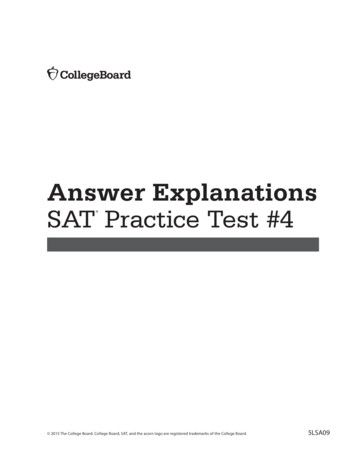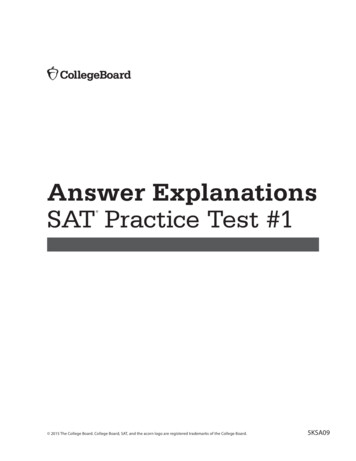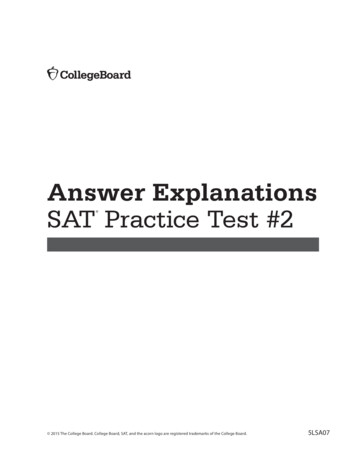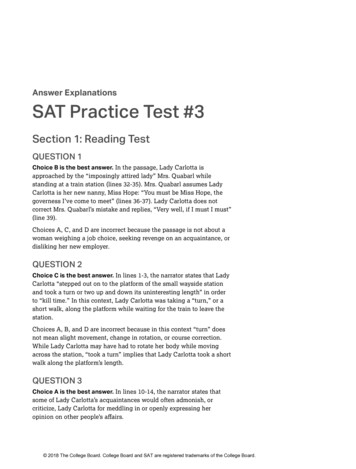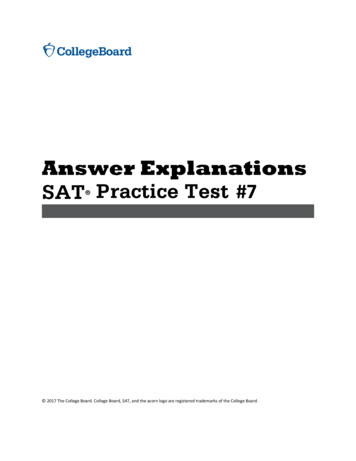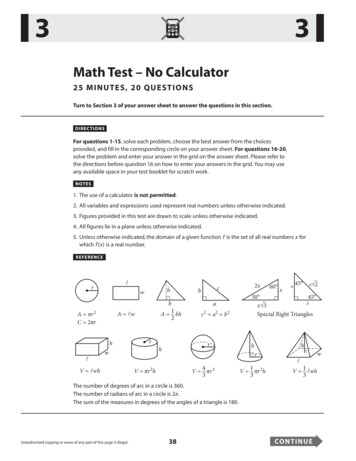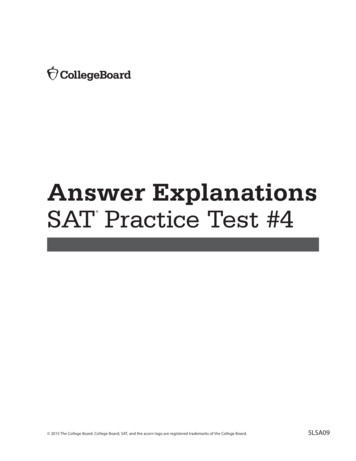
Transcription
Answer ExplanationsSAT Practice Test #4 2015 The College Board. College Board, SAT, and the acorn logo are registered trademarks of the College Board.5LSA09
Answer ExplanationsSAT Practice Test #4Section 1: Reading TestQUESTION 1.Choice C is the best answer. The narrator initially expresses uncertainty, oruneasiness, over his decision to set out for the North Pole: “my motives inthis undertaking are not entirely clear” (lines 9-10). At the end of the passage, the narrator recognizes that because of this journey he is “on the brinkof knowing . . . not an ethereal mathematical spot,” the North Pole, but himself (lines 56-57).Choices A, B, and D are incorrect because the narrator does not suggest thathe fears going on the expedition, doubts his own abilities, or feels disdain forthe North Pole.QUESTION 2.Choice D is the best answer. Lines 56-57 provide evidence that the narra-tor eventually recognizes his motives for traveling to the North Pole: “WhatI am on the brink of knowing, I now see, is not an ephemeral mathematicalspot but myself.” The narrator initially was unsure of why he was travelingto the North Pole, but realizes that he has embarked on a journey to findhimself.Choices A, B, and C are incorrect because they do not provide the best evidence that the narrator eventually recognizes his motives for traveling to theNorth Pole. Rather, choices A, B, and C all focus on the narrator’s preparations and expectations for the journey.QUESTION 3.Choice D is the best answer. In lines 1-6, the narrator says that he feels a“vast yearning” and that his emotions are “complicated.” He explains that hedoes “not understand quite what it is that the yearning desires.” In this context, his emotions are “not readily verifiable,” or not completely understood.1
Choices A, B, and C are incorrect because in this context, “not readily verifiable” does not mean unable to be authenticated, likely to be contradicted, orwithout empirical support.QUESTION 4.Choice C is the best answer. In lines 10-13, the narrator explains that “themachinery of [his] destiny has worked in secret” to prepare him for thisjourney, as “its clockwork” has propelled him to “this time and place.” Byusing the phrases “the machinery” and “its clockwork,” the narrator is showing that powerful and independent forces are causing him to journey to theNorth Pole.Choices A, B, and D are incorrect because they do not indicate the mainpurpose of lines 10-13. While lines 10-13 mention that these powerful andindependent forces have been working “for years, for a lifetime” to convincethe narrator to journey to the North Pole, they do not expose a hidden sideof the narrator, demonstrate the narrator’s manner, or explain the amount oftime the narrator has spent preparing for his expedition.QUESTION 5.Choice A is the best answer. In lines 20-21, the narrator states that manypeople have perished while journeying to the North Pole: “Nobody has succeeded in this thing, and many have died.”Choices B, C, and D are incorrect because the narrator does not indicate thatprevious explorers have made surprising discoveries, have failed to determine the exact location of the North Pole, or had different motivations thanhis own.QUESTION 6.Choice A is the best answer. In lines 20-21, the narrator provides evidencethat many previous explorers seeking the North Pole have perished in theattempt: “Nobody has succeeded in this thing, and many have died.”Choices B, C, and D do not mention previous explorers; therefore, theselines do not provide the best evidence that explorers died while seeking theNorth Pole.QUESTION 7.Choice B is the best answer. In lines 27-39, the narrator states that he is“intent” on traveling to the North Pole but acknowledges that the journeyis absurd: “Who wants the North Pole! What good is it! Can you eat it? Willit carry you from Gothenburg to Malmö like a railway?” By asking thesequestions, the narrator recognizes that the North Pole has no practical value.2
Still, the narrator admits that finding the North Pole is necessary, as it “mustnevertheless be sought for.”Choices A, C, and D are incorrect because the narrator does not view hisexpedition to the North Pole as immoral, socially beneficial, or scientificallyimportant.QUESTION 8.Choice D is the best answer. In lines 27-31, the narrator asks a series of rhe-torical questions about the North Pole: “Who wants the North Pole! Whatgood is it! Can you eat it? Will it carry you from Gothenburg to Malmö likea railway?” In this context, the narrator is suggesting that reaching the NorthPole has no foreseeable benefit or value to humanity; unlike trains that bringtravelers to specific destinations, the North Pole does not provide humanswith a specific benefit or form of convenience.Choices A, B, and C are incorrect because the question posed in lines 30-31does not debate modes of travel, examine the proximity of cities that can bereached by trains, or question how often people travel.QUESTION 9.Choice D is the best answer. In lines 48-49, the narrator states that theNorth Pole “is an abstraction, a mathematical fiction” and that “no one buta Swedish madman could take the slightest interest in it.” In this context, thenarrator is stating that people would not “take the slightest interest in,” or becurious about, the North Pole.Choices A, B, and C are incorrect because in this context, “take the slightestinterest in” does not mean to accept responsibility for, to possess little regardfor, or to pay no attention to something.QUESTION 10.Choice A is the best answer. In lines 49-51, the narrator describes his bal-loon journey toward the North Pole: “The wind is still from the south, bearing us steadily northward at the speed of a trotting dog.” In this context, thewind is “bearing,” or carrying, the narrator in a direction to the North.Choices B, C, and D are incorrect because in this context, “bearing” does notmean affecting, yielding, or enduring.QUESTION 11.Choice C is the best answer. The author states that “demographic inver-sion is not a proxy for population growth” (lines 32-33). In other words,demographic inversion is distinct from population growth. The author alsonotes that demographic inversion is evident in many American cities, as it3
“can occur in cities that are growing, those whose numbers are flat, and evenin those undergoing a modest decline in size” (lines 33-35).Choices A, B, and D are incorrect because they do not summarize the firstparagraph.QUESTION 12.Choice D is the best answer. The author notes that one of “the most power-ful demographic events of the past decade [was] the movement of AfricanAmericans out of central cities” (lines 14-17).Choices A, B, and C are incorrect because the author does not state that theunemployed, immigrants, or young professionals moved away from centralcity areas in large numbers in the early 2000s.QUESTION 13.Choice A is the best answer. The author states that democratic inversion“can occur in cities that are growing, those whose numbers are flat, and evenin those undergoing a modest decline in size” (lines 33-35). In this context,cities whose “numbers,” or population size, are “flat” have static, or unchanging, populations.Choices B, C, and D are incorrect because in this context, “flat” does notmean deflated, featureless, or obscure.QUESTION 14.Choice B is the best answer. The author states that many major Americancities are currently experiencing economic hardship, or “enormous fiscalproblems,” because of “public pension obligations they incurred in the moreprosperous years of the past two decades” (lines 36-39). The author thenprovides the example of Chicago, a city that can no longer afford to pay the“public services to which most of [its] citizens have grown to feel entitled”(lines 41-43). The author is arguing that many major American cities faceeconomic hardship due to past promises (such as public services) they madeto their constituents.Choices A, C, and D are incorrect because the passage does not discussexpected tax increases, an inner-city tax base, or manufacturing productionas they relate to the financial status of many major American cities.QUESTION 15.Choice A is the best answer. In lines 36-39, the author provides evidencethat many major American cities are currently experiencing economic hardship due to promises made in past years: “America’s major cities face enormous fiscal problems, many of them the result of public pension obligations4
they incurred in the more prosperous years of the past two decades.”America’s major cities made past promises, such as “public pension obligations,” to their citizens, which caused their current financial situation.Choices B, C, and D are incorrect because they do not provide evidence thatmany major American cities are currently experiencing economic hardshipdue to promises made in past years.QUESTION 16.Choice C is the best answer. The author explains how sociologist ErnestW. Burgess determined that urban areas have a traditional four-zone structure (lines 54-63). He then states that Burgess was “right about the urbanAmerica of 1974” (line 65) as it also followed the traditional four-zonestructure: “Virtually every city in the country had a downtown, where thecommercial life of the metropolis was conducted; it had a factory districtjust beyond; it had districts of working-class residences just beyond that;and it had residential suburbs for the wealthy and the upper middle class atthe far end of the continuum” (lines 66-71).Choices A, B, and D are incorrect because the passage does not imply thatAmerican cities in 1974 were witnessing the flight of minority populationsto the suburbs, had begun to lose their manufacturing sectors, or werealready experiencing demographic inversion.QUESTION 17.Choice C is the best answer. In lines 66-71, the author provides evidencethat American cities in 1974 had a traditional four-zone structure: “Virtuallyevery city in the country had a downtown, where the commercial life ofthe metropolis was conducted; it had a factory district just beyond; it haddistricts of working-class residences just beyond that; and it had residential suburbs for the wealthy and the upper middle class at the far end ofthe continuum.”Choices A, B, and D are incorrect because they do not provide evidencethat American urban cities in 1974 had a traditional four-zone structure.Choice A references a seminal paper on the layout of American cities, choiceB identifies Burgess’s original theory, and choice D focuses on movement tothe suburbs.QUESTION 18.Choice A is the best answer. In lines 66-68, the author notes that Americancities in 1974 each had a “downtown, where the commercial life of themetropolis was conducted.” In this context, the author is stating that thesecities “conducted,” or carried out, business, the “commercial life,” in downtown areas.5
Choices B, C, and D are incorrect because in this context, “conducted” doesnot mean supervised, regulated, or inhibited.QUESTION 19.Choice B is the best answer. Chart 1 shows the percentage of the US popu-lation in 2010 that lived in non-metro, small metro, and large metro areas.While the author cites census numbers, he notes that “when it comes tomeasuring demographic inversion, raw census numbers are an ineffectiveblunt instrument” (lines 11-13). Census data refer to the number of peopleliving in a specific area and the demographic information that’s been collected on them. The author would most likely consider the information inchart 1 to be possibly accurate but an “ineffective blunt instrument” that’snot truly informative.Choices A and C are incorrect because the author would not consider censusdata to be excellent or compelling. Choice D is incorrect because while theauthor does not believe the census completely explains demographic inversion, he would be unlikely to disagree with the census data.QUESTION 20.Choice A is the best answer. Chart 2 shows that the growth of all metro-politan areas in the 1990s was higher than the growth in all metropolitanareas in the 2000s: large metro areas experienced a growth of 14.3% in the1990s versus a growth of 10.9% in the 2000s, small metro areas experienceda growth of 13.1% in the 1990s versus a growth of 10.3% in the 2000s, andnon-metro areas experienced a growth of 9.0% in the 1990s versus a growthof 4.5% in the 2000s.Choices B, C, and D are incorrect because they do not accurately characterize the US growth rate by metro size from 2000-2010 as illustrated in chart 2.QUESTION 21.Choice D is the best answer. Chart 2 shows that in the 1990s the US pop-ulation increased in large metro, small metro, and non-metro areas whencompared to the population growth experienced in the 1980s. Large metroareas experienced a growth of 12.5% in the 1980s versus a growth of 14.3%in the 1990s, small metro areas experienced a growth of 8.8% in the 1980sversus a growth of 13.1% in the 1990s, and non-metro areas experienced agrowth of 1.8% in the 1980s versus a growth of 9.0% in the 1990s. Given thisinformation, the population grew more in all metro areas in the 1990s whencompared to the growth of those areas in the 1980s.Choices A, B, and C are incorrect because they do not draw an accurate conclusion about the US growth rate in the 1990s.6
QUESTION 22.Choice A is the best answer. Lines 9-11 introduce the focus of the passage:“Welcome to the world of ‘pharming,’ in which simple genetic tweaks turnanimals into living pharmaceutical factories.” The passage then discusses thechronological development of “pharming,” and describes ATryn, a usefuldrug produced after decades of laboratory experiments.Choices B and C are incorrect because the passage does not primarily evaluate research or summarize long-term research findings. Choice D is incorrect because “pharming” is not a branch of scientific study.QUESTION 23.Choice C is the best answer. The author is appreciative of pharming anddescribes it as turning “animals into living pha
Answer Explanations SAT Practice Test #4 Section 1: Reading Test QUESTION 1. Choice C is the best answer. The narrator initially expresses uncertainty, or uneasiness, over his decision to set out for the North Pole: “my motives in this undertaking are not entirely clear” (lines 9-10). At the end of the pas- sage, the narrator recognizes that because of this journey he is “on the brink of .
